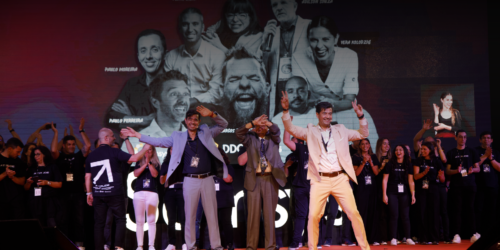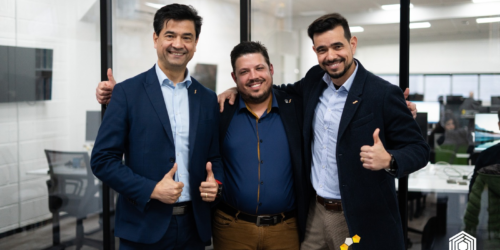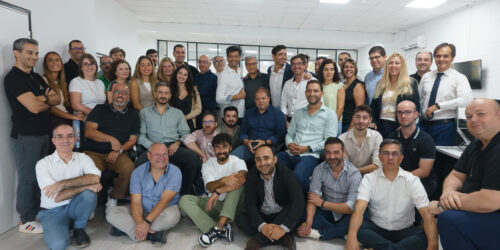With just over a month to go before the WordCamp Lisbon and just over two for the WordCamp Europe, community we follow closely since almost 100% of our web projects (institutional sites and web stores) are done with WordPress, I was in The Hague for the conference Meet Magento 2019 NL.
After Microsoft Ignite in January, Ecommerce Berlin in February and Deliver Conf in March, we continue our journey through European conferences that will help us to get to know foreign markets better, while gathering additional technical knowledge that may eventually help us to go further.
Magento or WordPress at Samsys?
It may seem contradictory or even uninteresting in terms of return on investment to participate in a conference on a platform (Magento) that we do not use daily, but the truth is that in addition to having some customers who use this platform and integrate it with ERPs we work with, for example using our PHC Magento Driver, we know that Magento is a relevant platform, and because it has always been focused on e-commerce, at some points, its community and the product itself can provide valuable lessons for those who use the combination of WordPress and WooCommerce in this type of solution.

Trends in Electronic Commerce
It is now about a year since the Adobe brought Magento into its product line and this was mentioned in the first session, where the major trends in global electronic commerce were discussed.
One of these trends is the growing importance of marketplaces, which will represent around 40% of all transactions in 2020, as well as the importance that users place on personalizing the shopping experience.
Also highlighted was the growing link between online and offline, whether in terms of data integration, or in terms of starting the shopping experience in one medium and then completing it in another
And they could not fail to even miss the buzzwords of the moment such as voice search or the use of artificial intelligence and machine learning throughout this process.
In addition, it also framed the acquisition of this product by Adobe in order to be able to have a product offer that allowed going from ideation or prototyping, solution design, in this case the design of an e-commerce solution, to the website itself. .

It was curious to realize that also at the product level more and more importance is given to product-related content, in addition to the typical product page, through the creation of landing-pages and other pages with personalized content and that this was reflected in the development of a page builder for Magento. This approach of the page builder is interesting because it is something that is very current in the WordPress community with the Gutenberg project as well as other projects like Beaver Builder or Elementor.
Magento PWA Studio
Another frequently discussed topic was the Magento PWA Studio, One platform to build Magento-based mobile applications. From what I understand for now, it is still a proof of concept (although it was released more than a year ago) and here too, there is a similarity with the WordPress community, it is clear that in some cases whoever leads (in a more formal or informal way) the process is not always manages to share with the rest of the community the path.
In this case it seems to be a little undefined, mainly the question of the dates when new versions of PWA Studio will be released, and mainly some technical approaches that will be followed (eg Reactive or Vue). At the same time, other people in the community are looking to make their way, as in this community it is also clear that mobile and especially having a mobile application associated with an online store is something increasingly relevant.
At the event there were some non-technical sessions, for example on marketing, among others, but in these cases almost always in Dutch so I kept to the technical sessions.
Even so, in a less technical session presented by BOL.com, “Platformization: new collaborations in Retail” by Nick Enthoven, there was talk of how marketplaces are a growing trend and how they can reach different segments, namely young families (couple and one or two children) who don't want to get home after work and still have to take care of food or other daily chores and who are therefore frequent users of this type of online product; but also for seniors who often have difficulty transporting their purchases home; and of course the so-called millennials who have an already native relationship with everything digital.
The guts of Magento
Going back to the technical sessions, there was a lot of talk about version 2.3 which seems to be a milestone in the community and seen as a reference version just like version 1.4 was.
Still wearing my developer shirt, it's interesting to see how standard concepts in this area of software development are being used, be it “dependency injection”, “plugins”, “observables”, “repositories”, etc. Concepts that we also use internally in our developments and that are also appearing in the WordPress community.
I think they just didn't talk about View Models, but the creation of elements for UI also seems very systematized.

All this mentioned in several sessions, namely in the most technical of all the ones I watched about the intended future for Magento with the suggestive title of “A long way from Monolit to Service Isolated Architecture” by Igor Miniailo. A presentation that almost needed an entire afternoon to be able to correctly convey everything that was intended to be done.
On a more specific note about the architecture of Magento, and more related to the domain of action of this software (online stores) it is interesting to note that the concept of Multi Source Inventory is already incorporated from scratch, something that is very important for some sellers.
Two sessions that stood out were the “So you want to develop with Magento", with David Manners and the "Half a rush hour of Magento 2” with Fabian Blechschmidt , both about Magento's “insides”, one more in terms of introduction (installation and the like) and another with a more general presentation perspective of the platform. Very interesting for those who, like me, do not work with the platform daily, but also very fun for the dynamic way in which it was made.
Software quality

Still from the perspective of learning new things and even applying them in our daily lives, the presentation “Tools to improve the quality of your Magento project” by Stephan Hochdorfer, was very interesting, as it focused on a set of tools, not specific to Magento, that allow improving the quality of the software development process in general and PHP development in particular. I registered to explore Captain Hook in the future (to help configure git hooks), PHPStan to validate PHP code developed well with the concept of Mutation Testing, which we can also apply to the .Net development that we also do.
All these sessions were held at the Louwman Museum, a very friendly space tailored to the community. In the common space there were about half a dozen companies, from Paypal (which is promoting a strong relationship with Magento), to hosting companies and bespoke development for Magento.
We also find some companies that are more focused on digital marketing and that provide multi-channel platforms that aggregate all this information about a customer, allowing then to follow on a dashboard different general and individual indicators of the website's performance.

The day ended beautifully with Slava Kravchuck's final presentation on her adventure in Africa, a lively and emotional description of her journey from Ukraine to South Africa. An appeal to us to pursue our dreams and to value what is most important in life, joy, simplicity… people.









